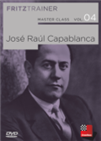Clarity of thought
If I have seen further than others, it is by standing upon the shoulders of giants
Isaac Newton
What can we learn from the (chess) machine? This is a common question that grips many a chess enthusiast these days. But what I wish to touch upon here is, what we can learn from the Cuban genius Jose Raul Capablanca, who was nicknamed “the chess machine”.
 He was a child prodigy and he is surrounded by legends. In his best times he was considered to be unbeatable and by many he was reckoned to be the greatest chess talent of all time: Jose Raul Capablanca, born 1888 in Havana.
He was a child prodigy and he is surrounded by legends. In his best times he was considered to be unbeatable and by many he was reckoned to be the greatest chess talent of all time: Jose Raul Capablanca, born 1888 in Havana. His play was characterized by quickness of thought, effortlessness of ideas and a brilliant intuition. He was rightly compared to Mozart, because of his early proficiency in the game. For him, chess was truly his native language! He was absolutely self-taught, and there are even myths that the first Chess book he read was the one he wrote :-). Chess Fundamentals is a fine book, which reflects Capablanca’s approach to chess. The underlying theme is simplicity and clarity of thought. Botvinnik once remarked, that whatever one needs to know about chess is contained in Capablanca’s book.
I feel Capa’s approach to chess is also shared by two of his esteemed successors — Robert Fischer and the current world champion Magnus Carlsen. When looking at their games, one cannot but help admire the clarity of thought and the tendency towards simplicity.
Although there is a popular opinion that the really old games are outdated and there is not much to learn from them, I do not really buy it. The point I wish to make is that the future great players have absorbed a lot from their predecessors, and the older masters, like Capablanca, were truly giants. I will share a few positions from the games of Capablanca, and look at it in comparison with similar ones that occurred in the games of later-day greats.
The first diagram is a game between Capablanca and Juan Corzo from the ninth game of their match in 1901. And the second diagram is from the second game of the match between Levon Aronian and Hikaru Nakamura played in Saint Louis in 2014. White won both these games, because of the better pawn structure (note how the four pawns of the opponent are effectively controlled by the three pawns plus the bishop controlling a colour complex) and the better minor piece (bishop against knight). White’s majority is more effective than his opponent's.
The first one here is from a very famous position from the game William Winter versus Capablanca in Hastings 1919, and the second one is from the (more) recent Nigel Short versus Vladimir Kramnik encounter from London 2011. Needless to say, Black won both the games by “cutting off pieces from the scene of action”, in the words of Capablanca! Take a look at the bishop imprisoned by his own pawns in both positions. Black simply won by taking the play to the other side of the board, where White effectively was down a piece in both the cases.
This was a position from the game Harry Kline versus Capablanca played in New York, 1913. Did Black’s surprising decision to part with a beautiful knight for a not-so-powerful bishop with 23...Nxd3! inspire Fischer in the following two games in his historic 1971 match versus Tigran Petrosian? Fischer chose 22.Nxd7!! in the seventh game as White in the first diagram, and chose 28...Nxb2! as Black in the sixth game of the match in the second diagram.
To conclude, let’s look at two positions, one from Capa’s praxis and the other from Magnus’. These were the final positions of their games where their opponents resigned. The strong central pawns sealed the deal for Black in both these games. Apart from that, the plan adopted by Magnus was quite similar to what Capa did in his game against Ilia Kan.
Black improved his pawn structure with every exchange, while the pawns, always captured towards the centre, succeeded in conquering more and more space which eventually resulted in a victory.
If the likes of Fischer, Kramnik and Carlsen can seek inspiration from Capablanca, why can’t we do the same?
You can go through the games mentioned in the article in the dynamic replayer below.
Select an entry from the list to switch between games
Links























